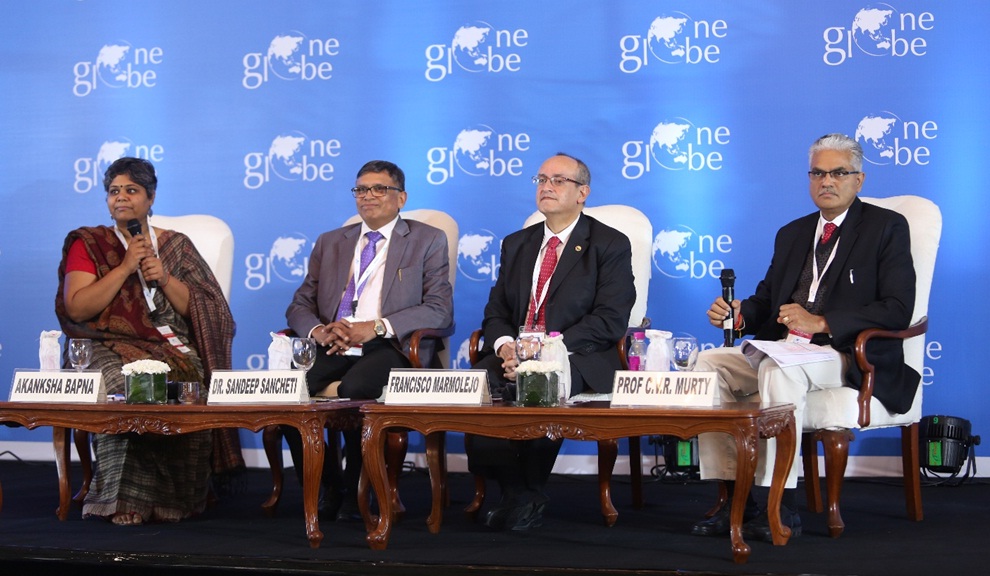How India can create a globally competitive higher education system
Posted by Admin on December 26, 2017

From left: Ms. Akanksha Bapna (CEO, Evaldesign), Mr. Sandeep Sancheti (President, Manipal University Jaipur), Mr. Francisco Marmolejo (Lead Tertiary Education Specialist, The World Bank), and Dr. C.V.R. Murty (Director, IIT Jodhpur)
.jpg) |
Over the next two decades, according to data from India’s Ministry of Labour & Employment, a million Indians will join the workforce every month. Others will choose to study further. At any given point, at least 30 million Indians will be pursuing higher education in India. To reap the demographic dividend, India will need to ensure that its higher education institutions graduate students who are employable and capable of keeping pace with the fast-evolving workspace.
At a panel session titled ‘Can India be a Global Destination for Science, Innovation and Higher Education?’ at the 2017 One Globe Forum, panelists discussed the challenges and opportunities in higher education. Francisco Marmolejo, Lead Tertiary Education Specialist, The World Bank, said, “Should India become a hub and an engine of science, technology, innovation and higher education? For India, I would say, definitively yes. And it is urgent to do that.”
India spends less than 1% of its GDP on science and technology, while peer countries such as China, Japan, Israel, and South Korea invest almost up to 4%. Only 13% of Indians, aged 25-64 are engaged in higher education, while for peer countries the number is approximately 40% - 60%. The challenge of transforming India’s higher education sector is quite significant.
Akanksha Bapna, Founder & CEO of Evaldesign, asked the panelists, “What should be the role of higher education institutions in fueling research and how do you compare it to the quality that industry can produce? What will it take for India to move from being copiers to innovators? From creating Ola to creating Uber?”
Prof. C.V.R. Murty, Director, IIT Jodhpur, responded that, first he would like to raise the alarm on the state of higher education in India. Higher education in India suffers from a paucity of quality teachers; another problem is that industry and academia work in silos when cross-pollination is imperative for ramping up higher education. The 1990s saw an emphasis on research, but 20 years on, India is only creating apps, not products. To push technological innovation, Prof. Murty noted that it was critical to engage students and teachers in research.
In the past, technological education has focused on component education instead of systemic education. As a result, Prof. Murty added, students graduate without an end-to-end picture of how even a single product gets made, or works. To change this, he advised discrimination in designing curriculums and programs, “We need to pick up substantive activities. There is a lot of eyecatching activity going on in higher education system, which is easy and convenient to do, and it is a buzzword – we’re falling prey to that.”
On whether India needed to focus more on applied or basic research, Prof. Murty replied, “The nation can’t afford this continental divide.” Innovation requires the whole spectrum of knowledge: science, engineering, and technology.
To evaluate whether HEIs are able to deliver in this context, we need measures of quality. Rankings seems the obvious answer. However, Mr. Marmolejo was skeptical about rankings. Instead, he stated that the three global parameters of higher education: equitable access, retention, and success (students graduate on time and with the right tools), were the best criteria for evaluating institutions and systems.
The next issue discussed by the panel was autonomy, which academics believe are central to ensuring quality. The problem in India, according to Dr. Sandeep Sancheti, President, Manipal University - Jaipur, was that each element of an HEI interprets autonomy as personal freedom. This hampers workflow and leads to poor results. He continued, “The model of autonomy for me would be some sort of graduation in certain operations, decentralization of operations . . . empowerment of faculty [and] even empowerment students in terms of choosing courses, etc.”
India can, given its demographic and other resources, become a global destination for science and higher education. But, it must overhaul its internal education system first. Mr. Marmolejo summed up the panel’s thoughts by stating that “India should be a significant engine for economic development for [itself] first, for the region & then for the world. For that matter, higher education will need to become a significant player.”








